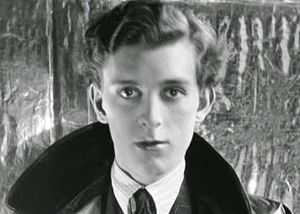Stephen Tennant

Stephen James Napier Tennant (21 April 1906 – 28 February 1987) was a British aristocrat known for his decadent lifestyle.
Early life
He was born in England, the youngest son of a Scots peer, Edward Priaulx Tennant, 1st Baron Glenconner, and the former Pamela Wyndham, one of the Wyndham sisters and of The Souls clique. His mother was also a cousin of Lord Alfred Douglas (1870–1945), Oscar Wilde's lover and a sonneteer. On his father's death, Tennant's mother married Lord Grey, a fellow bird-lover. Tennant's eldest brother Edward – "Bim" – was killed in the First World War.
Social set
During the 20s and 30s, Tennant was an important member – the "Brightest", it is said – of the "Bright Young People." His friends included Rex Whistler, Cecil Beaton, the Sitwells, Lady Diana Manners and the Mitford girls. He is widely considered to be the model for Cedric Hampton in Nancy Mitford's novel Love in a Cold Climate; one of the inspirations for Lord Sebastian Flyte in Waugh's Brideshead Revisited, and a model for Hon. Miles Malpractice in some of his other novels.
Writing
For most of his life, Tennant tried to start or finish a novel – Lascar: A Story You Must Forget.[1] It is popularly believed that he spent the last 17 years of his life in bed at his family manor at Wilsford cum Lake, Wiltshire, which he had redecorated by Syrie Maugham. Though undoubtedly idle, he was not truly lethargic: he made several visits to the United States and Italy, and struck up many new friendships, despite his later reputation as a recluse. This became increasingly true only towards the last years of his life. Yet even then, his life was not uneventful: he became landlord to V. S. Naipaul who immortalised Tennant in his novel The Enigma of Arrival.
Personal life
During the 1920s and 1930s, Tennant had a sexual affair with the poet Siegfried Sassoon.[2] Prior to this he had proposed to a friend, Elizabeth Lowndes, but had been rejected. (Hoare relates how Tennant discussed plans with Lowndes about bringing his Nanny with them on their honeymoon.) His relationship with Sassoon, however, was to be his most important: it lasted some four years before Tennant off-handedly put an abrupt end to it. Sassoon was reportedly depressed afterwards for three months, until Sassoon married in 1933 and became a father in 1936. When Tennant died in 1987, he had far outlived most of his contemporaries.
References
- Philip Hoare: Serious Pleasures: The Life of Stephen Tennant (1992)
- ↑ http://www.bookforum.com/inprint/1705/7005
- ↑ Gianoulis, Tina (2005). "Sassoon, Siegfried". glbtq.com. Retrieved 12 August 2007.
|